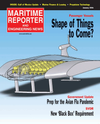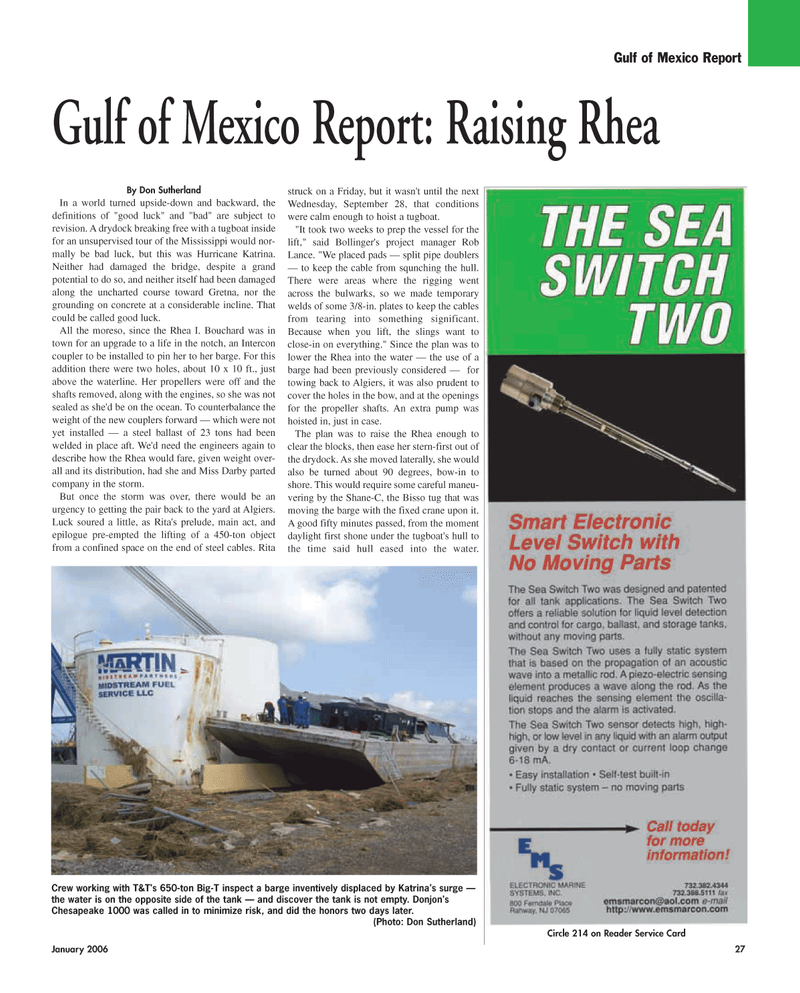
Page 27: of Maritime Reporter Magazine (January 2006)
Passenger Vessel Annual
Read this page in Pdf, Flash or Html5 edition of January 2006 Maritime Reporter Magazine
January 2006 27
By Don Sutherland
In a world turned upside-down and backward, the definitions of "good luck" and "bad" are subject to revision. A drydock breaking free with a tugboat inside for an unsupervised tour of the Mississippi would nor- mally be bad luck, but this was Hurricane Katrina.
Neither had damaged the bridge, despite a grand potential to do so, and neither itself had been damaged along the uncharted course toward Gretna, nor the grounding on concrete at a considerable incline. That could be called good luck.
All the moreso, since the Rhea I. Bouchard was in town for an upgrade to a life in the notch, an Intercon coupler to be installed to pin her to her barge. For this addition there were two holes, about 10 x 10 ft., just above the waterline. Her propellers were off and the shafts removed, along with the engines, so she was not sealed as she'd be on the ocean. To counterbalance the weight of the new couplers forward — which were not yet installed — a steel ballast of 23 tons had been welded in place aft. We'd need the engineers again to describe how the Rhea would fare, given weight over- all and its distribution, had she and Miss Darby parted company in the storm.
But once the storm was over, there would be an urgency to getting the pair back to the yard at Algiers.
Luck soured a little, as Rita's prelude, main act, and epilogue pre-empted the lifting of a 450-ton object from a confined space on the end of steel cables. Rita struck on a Friday, but it wasn't until the next
Wednesday, September 28, that conditions were calm enough to hoist a tugboat. "It took two weeks to prep the vessel for the lift," said Bollinger's project manager Rob
Lance. "We placed pads — split pipe doublers — to keep the cable from squnching the hull.
There were areas where the rigging went across the bulwarks, so we made temporary welds of some 3/8-in. plates to keep the cables from tearing into something significant.
Because when you lift, the slings want to close-in on everything." Since the plan was to lower the Rhea into the water — the use of a barge had been previously considered — for towing back to Algiers, it was also prudent to cover the holes in the bow, and at the openings for the propeller shafts. An extra pump was hoisted in, just in case.
The plan was to raise the Rhea enough to clear the blocks, then ease her stern-first out of the drydock. As she moved laterally, she would also be turned about 90 degrees, bow-in to shore. This would require some careful maneu- vering by the Shane-C, the Bisso tug that was moving the barge with the fixed crane upon it.
A good fifty minutes passed, from the moment daylight first shone under the tugboat's hull to the time said hull eased into the water.
Gulf of Mexico Report
Circle 214 on Reader Service Card
Gulf of Mexico Report: Raising Rhea
Crew working with T&T's 650-ton Big-T inspect a barge inventively displaced by Katrina's surge — the water is on the opposite side of the tank — and discover the tank is not empty. Donjon's
Chesapeake 1000 was called in to minimize risk, and did the honors two days later. (Photo: Don Sutherland)
MR JANUARY2006 #4 (25-32).qxd 1/3/2006 5:23 PM Page 27

 26
26

 28
28
